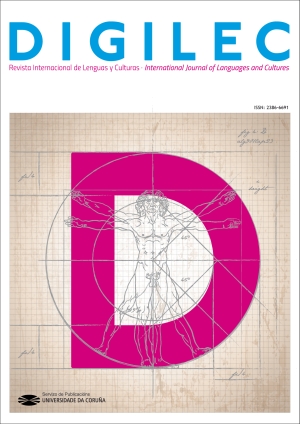Voces de una infancia silenciada: transitoriedad como espacialidad descentralizadora en tres películas contemporáneas
Contenido principal del artículo
Resumen
Este artículo pone en diálogo la relación entre producción espacial, configuración del lugar y desarrollo de la identidad, para cuestionarla a través de la óptica de tres directores de cine de procedencia transnacional. En sus películas Huelepega: La ley de la calle (Elia Schneider), Le temps du loup (Michael Haneke) y Children Underground (Edet Belzberg) estos autores presentan las dificultades experimentadas tanto por niños que han sido abandonados como por jóvenes adultos problemáticos, cuyas erráticas vidas los han obligado a vivir en lugares de transición. Este ensayo analiza las consecuencias espaciales que surgen de la confrontación de la infancia y su reterritorialización, y explora las ramificaciones de estas interacciones en términos de espacialidad y resignificación del lugar.
Palabras clave:
Descargas
Detalles del artículo
Citas
Arndt, S. (2018). Early childhood teacher cultural otherness and belonging. Contemporary Issues in Early Childhood, 19 (4), 392-403.
Ashcroft, R. E. (2003). American Biofutures: Ideology and Utopia in the Fukuyama/Stock Debate. Journal of Med Ethics, 29, 59-62.
Augé, M. (2008). Non-places: Introduction to an Anthropology of Supermodernity. London: Verso.
Barros-Grela, E. and Bobadilla Pérez (2015). Space and Children in Post-Apocalyptic Film: The Road and Les temps du loup. In The Child in Post-Apocalyptic Cinema, D. Olson (ed.), 77-90. Lanham, MD: Lexington Books.
Belzberg, E. (Director). (2001). Children Underground [Film]. Belzberg Films.
Bolzan, N. & Gale F. (2012). Using an Interrupted Space to Explore Social Resilience with Marginalized Young People. Qualitative Social Work, 11 (5), 502-516. https://doi.org/10.1177/1473325011403959
Daly Bednarek, J. R. (2019). Place or Non-place: The Relationship between Cities and Their Airports. Journal of Urban History, 45 (2), 386-392.
Davis, M. (2003). Dead Cities and Other Tales. London and New York: Verso.
Davis, M. (2007a). Evil Paradises. Dreamworlds of Neoliberalism. London and New York: Verso.
Davis, M. (2007b). Planet of Slums. London and New York: Verso.
Deleuze, G. & Guattari, F. (2001). Pure Immanence: Essays on a Life. (Trans. J. Raichman). New York: Zone Books.
Deleuze, G. & Guattari, F. (2004a). A Thousand Plateaus: Capitalism and Schizophrenia. London and New York: Continuum International Publishing Group.
Deleuze, G. & Guattari, F. (2004b). The Logic of Sense. London and New York: Continuum International Publishing Group.
Fattore, T. (2016). Children’s Conceptions of Otherness: Constructions of the ‘Moral Self’ and Implications for Experiences of Migration. In Childhood, Youth and Migration, C. Hunner-Kreisel & S. Bohne (ed.), 49-62. Berlin: Springer.
Fukuyama, F. (1992). The End of History and the Last Man. New York: Basic.
Haneke, M. (Director). (2003). Le Temps du Loup. [Film]. Arte France Cinéma.
Kjeldgaard, D. & Askegaard, S. (2006). The glocalization of youth culture: The global youth segment as structures of common difference. Journal of Consumer Research, 33 (2), 231-247.
Lévèque, M. (2017). Les Childhood Studies in France: Esquisses d’un domaine à construire. Hypotheses.org, 9 Feb. https://magasindesenfants.hypotheses.org/5894
Malone K., Tesar, M. & Arndt, S. (2020). History and Philosophy of Children and Childhoods. In Theorising Posthuman Childhood Studies. Children: Global Posthumanist Perspectives and Materialist Theories, K. Malone, M. Tesar, & S. Arndt (eds.), 1-25. Berlin: Springer.
Nosál, I. (2009). Governing Abandoned Children: The Discursive Construction of Space in the Case of ‘Babybox’. In Discourse and Transformation in Central and Eastern Europe, A. Galasińska & M. Krzyżanowski (eds.), 114-136. Basingstoke: Palgrave Macmillan.
Oliver, K. (1998). Subjectivity Without Subjects: From Abject Fathers to Desiring Mothers. Lanham, Boulder, New York & Oxford: Rowman and Littlefield Publishers.
Preyer, G. & Bös, M. (2013). Borderlines in a Globalized World: New Perspectives in a Sociology of the World-System. Berlin: Springer.
Qvortrup, J. et al. (eds.). (2009). The Palgrave handbook of childhood studies. Basingstoke: Palgrave Macmillan.
Rumbaut, R. G. (1994). The Crucible within: Ethnic Identity, Self-Esteem, and Segmented Assimilation among Children of Immigrants. International Migration Review, 28 (4), 748-794.
Sack, R. (1986). Human Territoriality. Its Theory and History. Cambridge: Cambridge University Press.
Schneider, E. K. (Director). (1999). Huelepega. Ley de la calle. [Film]. Joel Films.
Soja, E. W. (1971) The Political Organization of Space, Washington: Association of American Geographers.
Waley, P. (1992). Fragments of a City: A Tokyo Anthology, Tokyo: The Japan Times.
Wall, J. (2019a). From childhood studies to childism: reconstructing the scholarly and social imaginations”. Children’s Geographies, 1-14. https://doi.org/10.1080/14733285.2019.1668912
Wall, J. (2019b). Theorizing children’s global citizenship: Reconstructionism and the politics of deep interdependence. Global Studies of Childhood, 9 (1), 5-17.
Woodhead, M. (2008). Childhood Studies: Past, Present and Future. In An Introduction to Childhood Studies, M. J. Kehily (ed.), 17-34. New York: McGraw-Hill Education.
Žižek, S. (2003). Organs without Bodies: Deleuze and Consequences. New York: Routledge.


